Erika Bragdon is a Certified Essential Oil Coach from the Essential Oil Institute.
My post on how to use essential oils for dry skin has been so popular, I’ve had readers asking me to share more essential oils for skincare.
In this post, we’ll talk about the best essential oils for acne, pimples, breakouts, and oily skin, what carrier oils have the most benefits, plus how to make a simple “skin-soothing” essential oil roll-on recipe.
It may seem tough to get that glowing, clear, healthy skin that is so desired, but the truth is there are many factors that affect skin health, including diet, nutrition, sleep, stress levels, hormones, what you put on your skin, and more. No two people are exactly the same and that is why one person may have great results with one treatment while another does not.
I had horrible acne all over my forehead from my teens well into my 20s. It hurt and was embarrassing. I finally discovered that dairy made my breakouts worse and once I cut back on dairy, it improved. Now, I can eat dairy again, but I try not to overdo it or a pimple or two will pop up.
If that does happen, I use a few of the essential oils listed in this post and it clears up quickly.
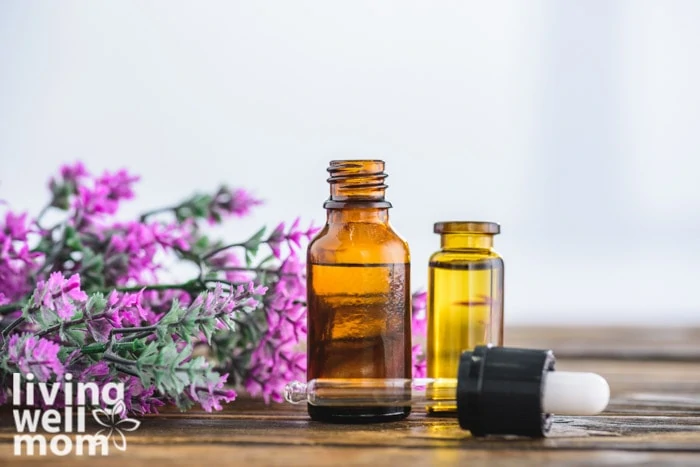
What Essential Oils Are Good for Acne?
These essential oils are listed in alphabetical order (not the best.)
- Cedarwood
- Chamomile, Roman
- Clary Sage
- Coriander
- Frankincense
- Geranium
- Helichrysum
- Juniper Berry
- Lavender
- Lemongrass
- Manuka
- Melissa
- Peppermint
- Rosemary
- Sandalwood
- Thyme
- Tea Tree
- Ylang Ylang
Keep reading to see why these are the best essential oils for acne and their safety tips.
Please read this post on essential oil safety before using these or any other essential oils.
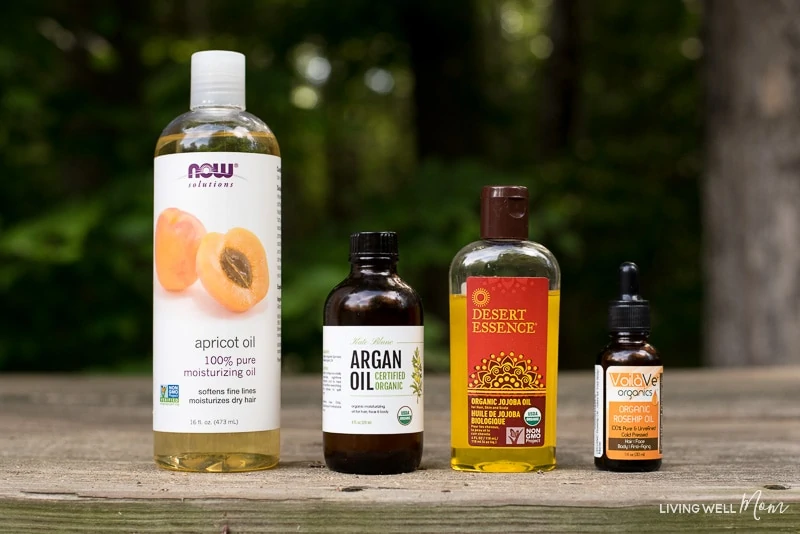
You may notice that “carrier oil” is mentioned frequently below. A carrier oil is simply another type of oil that is used to “carry” the essential oils to the skin and it also dilutes them for safer use. It helps to reduce any skin irritation and helps the essential oils to absorb into the skin more readily.
How do you dilute essential oils for acne? Simply mix one or more drops of essential oils with a carrier oil.
The most common carrier oil is fractionated coconut oil (a type of coconut oil that does not solidify in colder temperatures). Read more about coconut oil for acne here.
Other carrier oils are: almond oil, apricot kernel oil, avocado oil, evening primrose oil, hemp oil, jojoba oil, olive oil, rosehip oil, sea buckthorn, shea butter, and argan oil.
Argan oil, in particular, is one of the most popular oils for acne, as it helps to balance red, irritated skin.
18 Best Essential Oils for Pimples
Cedarwood Essential Oil
Also called Cedarwood Atlas
Latin name: Cedrus atlantica
Cedarwood essential oil has been known to have anti-inflammatory, antiseptic, and astringent properties. It may help calm irritation and reduce excessive oil.
Safety Notes: Cedarwood is generally considered to be safe and well accepted. There are no noted contraindications or hazards associated with this essential oil.
I recommend this one.
Chamomile, Roman
Latin name: Anthemis nobilis

Roman Chamomile essential oil has been known to have anti-inflammatory and anti-bacterial properties and can be excellent for soothing, hydrating, and balancing oily, acne-prone skin.
Safety Notes: Roman Chamomile is generally considered to be safe and well accepted for most people. There are no noted contraindications or hazards associated with this essential oil.
I recommend this one.
Clary Sage Essential Oil
Latin name: Salvica sclarea
Clary sage essential oil has been known to have anti-inflammatory properties and many have reported amazing results in using this oil, particularly when the acne is associated with hormonal imbalances. It can also help reduce the size of pores.
My recommendation: Because clary sage can work on a hormonal level, this is best used if you feel your blemishes are related to PMS or teenage hormones. it is best to test a very small amount for a short period to see how it affects you before using frequently.
Safety Notes: There is a moderate risk of skin sensitization (or irritation) when using clary sage. For the safest results, use at a higher dilution rate (less essential oil and more carrier oil for blending.) The safest rate with no known reactions is 0.25% meaning 1 drop essential oil with 4 tsp carrier oil. Since that is difficult to do, I suggest starting with a 0.5% dilution rate (1 drop essential oil to 2 tsp carrier oil) and increasing slowly if needed.
I recommend this one.
Coriander Essential Oil
Also called Coriander Seed
Latin name: Coriandrum sativum
Coriander essential oil has been known to have anti-inflammatory and soothing properties which may help calm and restore skin after pimples and breakouts.
Safety Notes: Coriander is generally considered to be safe and well-accepted. There are no noted contraindications or hazards associated with this essential oil.
I recommend this one.
Eucalyptus Essential Oil
There are 2 common types of eucalyptus oil:
Latin names: Eucalyptus globulus, Eucalyptus radiata
Eucalyptus essential oil has been known to have anti-microbial properties which means it may help prevent infection that sometimes occurs with popped pimples.
Safety Notes: One of the compounds found in Eucalyptus, 1,8-cineole has the potential to cause breathing problems in young children. Do not apply eucalyptus to or near the face of children under age 10. For teens and adults, it is generally well-tolerated at up to a 20% dilution rate (no more than 20 drops per 1 teaspoon carrier oil.)
I recommend this one.
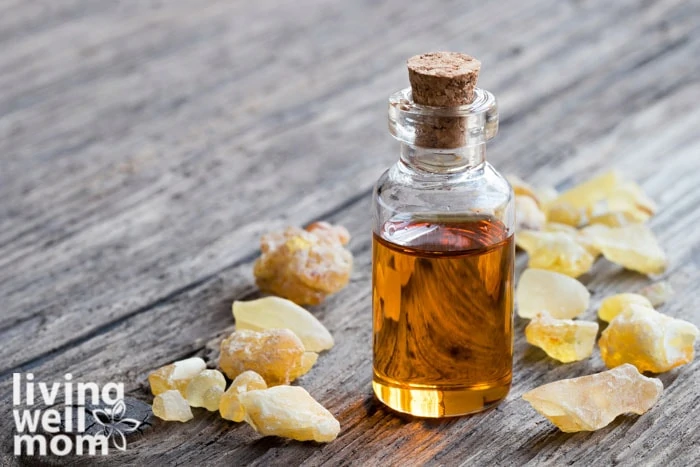
Frankincense Essential Oil
There are three common types of Frankincense essential oil:
Latin names: Boswellia frereana, Boswellia sacra, Boswellia serrata
Frankincense essential oil has been known to have anti-inflammatory and restorative properties which may help balance oily skin and reduce acne scarring.
Safety Notes: Frankincense has a low risk of any issues and is generally well accepted by most people. It is prone to oxidization issues which means you should keep the bottle tightly capped and stored in a cool, dark location. If the oil does become oxidized, it may cause skin irritation or sensitization.
I recommend this one and this roller blend.
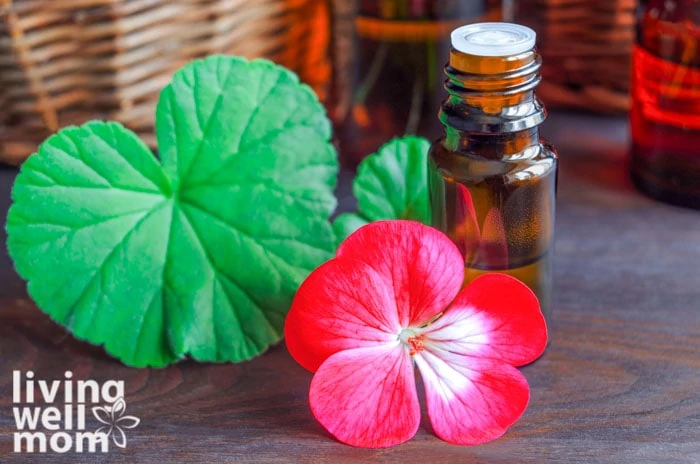
Geranium Essential Oil
Latin name: Pelargonium x asperum
Geranium essential oil has been known to have anti-inflammatory, astringent, and hydrating properties meaning it’s great for balancing all skin types, from dry to oily to combination types.
Safety Notes: Geranium has a low risk of any issues and is generally well tolerated at up to a 17.5% dilution rate (no more than 17 drops per 1 teaspoon carrier oil) for teens and adults.
I recommend this one.
Helichrysum Essential Oil
Latin name: Helichrysum italicum, angustifolium
Helichrysum essential oil is extremely hydrating and balancing for oily skin and may be helpful at reducing acne scars. It is one of my favorite essential oils to use in any skincare recipe.
Safety Notes: Helichrysum is generally considered to be safe and well-accepted. There are no noted contraindications or hazards associated with this essential oil.
While Helichrysum is one of the more expensive essential oils and can cost upwards of $100/bottle, I use this more affordable and still pure one from Eden’s Garden and it’s one of my favorites.
Juniper Berry Essential Oil
Latin name: Juniperus communi
Juniper Berry has been known to have antiseptic and astringent properties. It can be soothing without drying.
Safety Notes: Juniper Berry has a low risk of any issues and is generally well accepted. It is prone to oxidization issues which means you should keep the bottle tightly capped and stored in a cool, dark location. If the oil does become oxidized, it may cause skin irritation or sensitization.
I recommend this one.
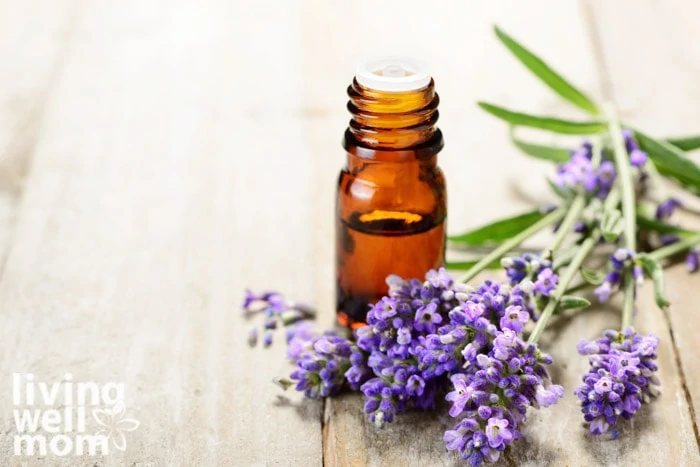
Lavender Essential Oil
Latin name: Lavandula angustifolia
Lavender essential oil has been known to have calming, astringent properties and is excellent for balancing all skin types. It’s also helpful at soothing painful cystic acne and may help with acne scars.
Safety Notes: Lavender is generally considered to be safe and well-accepted. There are no noted contraindications or hazards associated with this essential oil.
Get it here.
Lemongrass Essential oil
Latin names: Cymbopogon flexuosus, Andropogon flexusos, Cymbopogon citratus
Lemongrass essential oil has been known to have astringent, anti-inflammatory, antiseptic, and regenerative properties. It may help even your skin tone.
Safety Notes: Avoid during pregnancy or when nursing. Do not use on children under age 2. According to the safety recommendations of Robert Tisserand and Rodney Young, Lemongrass may cause sensitization (a build-up leading to future irritation) if used at a higher than 0.7% dilution rate. This means you should not use more than 1 drop of lemongrass essential oil for every 2 teaspoons of carrier oil.
I recommend this one.
Manuka Essential Oil
Latin name: Leptospermum scoparium
Manuka essential oil has anti-inflammatory and has been known to have anti-bacterial properties as well and can be helpful at soothing red, irritated skin.
Safety Notes: Manuka is generally considered to be safe and well-accepted. There are no noted contraindications or hazards associated with this essential oil.
I recommend this one.
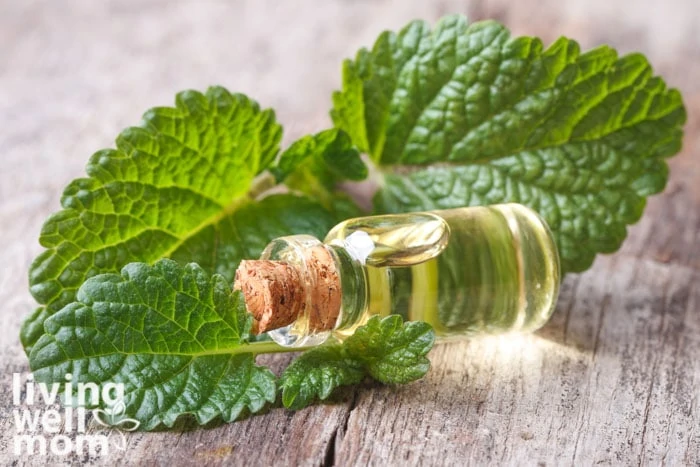
Melissa Essential Oil
Latin name: Melissa officinalis
Melissa essential oil has been known to have anti-inflammatory properties and can be strengthening and soothing for red, irritated skin.
Safety Notes: Do not use on children under age 2. According to the safety recommendations of Robert Tisserand and Rodney Young, Melissa may cause sensitization (a build-up leading to future irritation) if used at a higher than 0.9% dilution rate. This means you should not use more than 1 drop of melissa essential oil for every 1 teaspoon of carrier oil.
Note: Melissa is a more expensive essential oil and is frequently adulterated (lower quality oil is mixed into a very small amount of the higher quality real melissa) and sold as “pure.” Be careful of this. If you find Melissa cheap, it is probably fake or has poor quality ingredients that won’t help you or your family.
I bought a bottle of diluted pure melissa essential oil and it was much more affordable. This is the one I use.
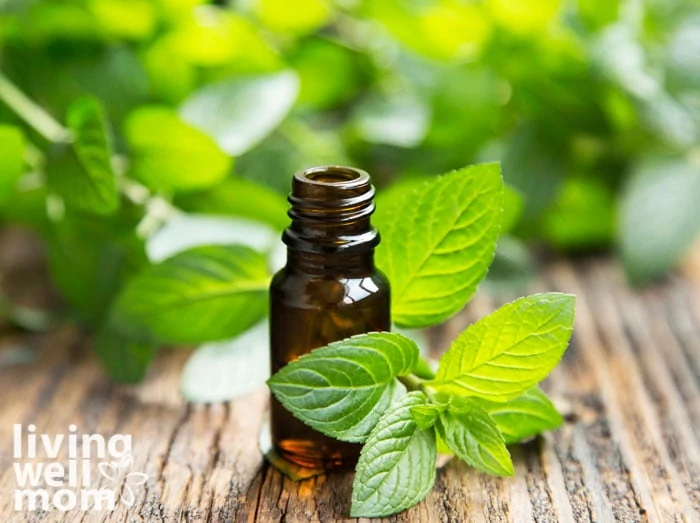
Peppermint Essential Oil
Latin name: mentha x peperita
Peppermint Essential Oil has been known to have anti-bacterial properties which means it may help reduce bacteria related to acne.
Safety Notes: One of the compounds found in Eucalyptus, 1,8-cineole has the potential to cause breathing problems in young children. Do not apply peppermint to or near the face of children under age 10. Do not use at all on children under age 3. For teens and adults, it is generally well-tolerated at up to a 5.4% dilution rate (no more than 7 drops per 1 teaspoon carrier oil.)
I recommend this one.
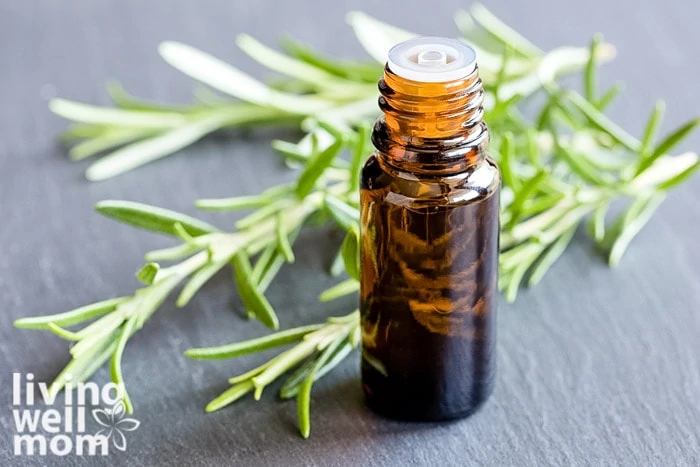
Rosemary Essential Oil
Latin name: Rosmarinus officinalis
Rosemary Essential Oil has astringent type properties which means it may help leave your skin feeling more balanced and refreshed.
Safety Notes: One of the compounds found in Rosemary, 1,8-cineole has the potential to cause breathing problems in young children. Do not apply rosemary to or near the face of children under age 10. For teens and adults, it is generally well-tolerated.
I recommend this one.
Sandalwood Essential Oil
Also called Hawaiian Sandalwood or Australian Sandalwood
Latin names: Santalum paniculatum (Hawaiian), Santalum spicatum (Australian)
Sandalwood essential oil has been known to have anti-inflammatory and anti-bacterial properties which means it has the potential to help soothe and restore oily skin while even reducing acne due to bacteria.
Safety Notes: Sandalwood is generally considered to be safe and well-accepted. There are no noted contraindications or hazards associated with this essential oil.
This is another more expensive essential oil. Eden’s Garden has a good affordable option and you can also choose to get a prediluted version like this one.
Tea Tree Essential Oil
Also known as Melaleuca essential oil
Latin name: Melaleuca alternifolia
Tea tree essential oil has been one of the #1 best home remedies for acne and is also one of the most studied natural options. It has known anti-inflammatory, anti-bacterial, and antiseptic properties. It has been known to help improve oily skin, soothe pimples, and cool inflammation. The antibacterial properties may help reduce the chance of infection due to popped pimples.
Safety Notes: Tea Tree oil has a low risk of any issues and is generally well accepted by most people at a dilution rate of up to 15% (no more than 21 drops tea tree for every 1 teaspoon carrier oil.) It is prone to oxidization issues which means you should keep the bottle tightly capped and stored in a cool, dark location. If the oil does become oxidized, it may cause skin irritation or sensitization.
I recommend this one.
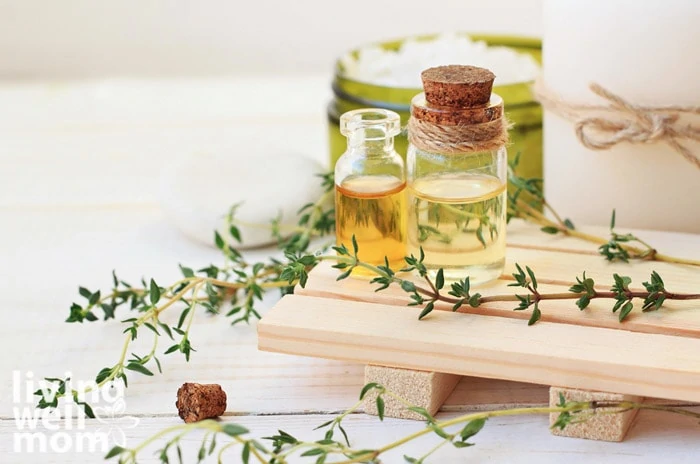
Thyme Essential Oil
Latin name: Thymus vulgaris
Thyme essential oil has been known to have antibacterial properties and has the potential to help prevent infection with broken skin.
Safety Notes: Thyme oil has a low risk of any issues and is generally well accepted by most people.
I recommend this one.
Ylang Ylang Essential Oil
Latin name: Cananga odorata
Ylang Ylang Essential Oil has been helpful at balancing and calming oily skin. It’s also extremely soothing and calming for emotions too (great if you suffer from breakouts during PMS).
Safety Notes: Ylang Ylang has a moderate risk of skin sensitization (or irritation) and is best used at no more than 0.8% dilution rate (about 2 drops ylang ylang to every 2 tsp carrier oil.)
I recommend this one.
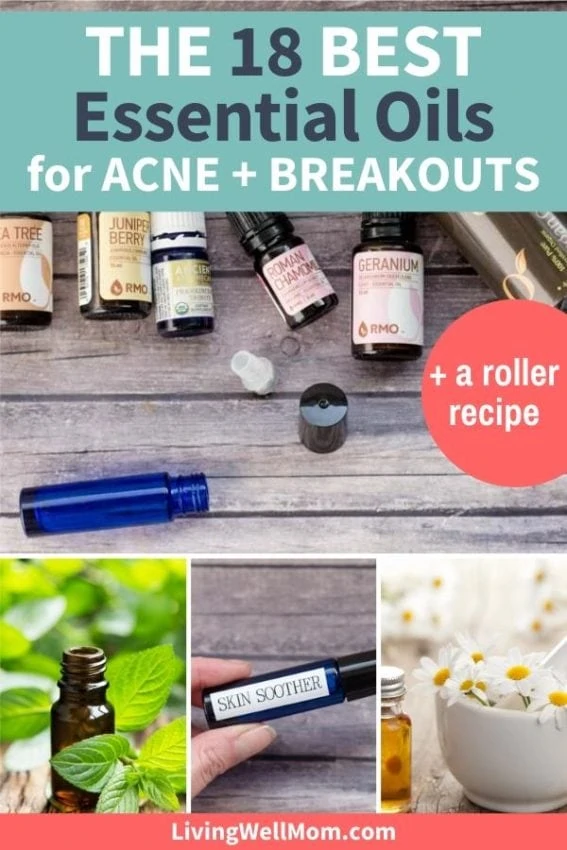
More Beneficial Essential Oils for Breakouts:
These five essential oils may also help purify skin and help with acne and breakouts, however, they should be used more cautiously because they have more chances of side effects. I prefer to use the essential oils listed above as I believe they are a bit safer.
Bergamot essential oil
Latin Name: Citrus bergamia
Bergamot essential oil has been known to have anti-inflammatory, anti-bacterial, and anti-fungal properties. It may help calm redness and possibly reduce bacteria that may be associated with acne.
Safety Notes: According to the safety recommendations of Robert Tisserand and Rodney Young, Bergamot is a citrus essential oil and may cause phototoxicity (increased sensitivity to sunlight and UV rays) if used at a higher than 0.4% dilution rate. This means you should not use more than 1 drop of bergamot essential oil for every 2 teaspoons of carrier oil. If you do use more, you should avoid exposure to the sun or other UV rays for 12 hours.
Grapefruit Essential Oil
Latin name: Citrus paradisi
Grapefruit essential oil has been known to have anti-inflammatory, antiseptic, and astringent-like properties which means it can be helpful for balancing oily skin.
Safety Notes: According to the safety recommendations of Robert Tisserand and Rodney Young, Grapefruit is a citrus essential oil and may cause phototoxicity (increased sensitivity to sunlight and UV rays) if used at a higher than 4% dilution rate. This means you should not use more than 4 drops of grapefruit essential oil for every 1 teaspoon of carrier oil. If you do use more, you should avoid exposure to the sun or other UV rays for 12 hours. Grapefruit is also prone to oxidization issues which means you should keep the bottle tightly capped and stored in a cool, dark location.
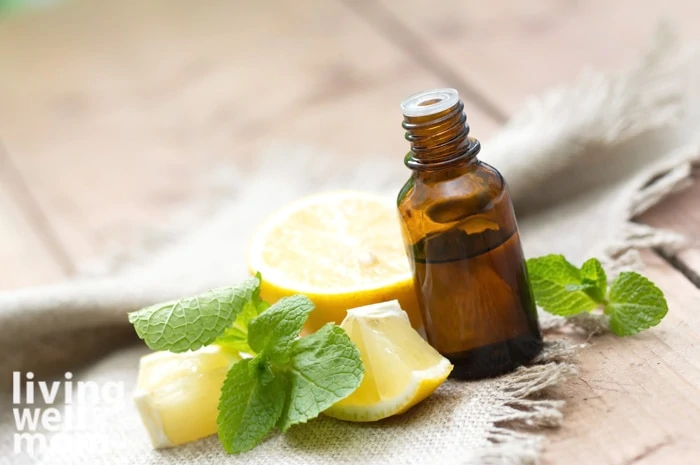
Lemon Essential Oil
Latin name: Citrus limon
Lemon essential oil actually has similar properties to that of salicylic acid and is excellent for balancing oily skin.
Safety Notes: According to the safety recommendations of Robert Tisserand and Rodney Young, Lemon may cause phototoxicity (increased sensitivity to sunlight and UV rays) if used at a higher than 2% dilution rate. This means you should not use more than 2 drops of grapefruit essential oil for every 1 teaspoon of carrier oil. If you do use more, you should avoid exposure to the sun or other UV rays for 12 hours. Lemon is also prone to oxidization issues which means you should keep the bottle tightly capped and stored in a cool, dark location.
Lime Essential Oil
Latin name: Citrus aurantifolia
Lime essential oil has been known to have antibacterial, anti-inflammatory, and antiseptic properties. It may help both reduce and prevent acne.
Safety Notes: According to the safety recommendations of Robert Tisserand and Rodney Young, Limemay cause phototoxicity (increased sensitivity to sunlight and UV rays) if used at a higher than 0.7% dilution rate. This means you should not use more than 1 drop of lime essential oil for every 1 teaspoon of carrier oil. If you do use more, you should avoid exposure to the sun or other UV rays for 12 hours. Lime is also prone to oxidization issues which means you should keep the bottle tightly capped and stored in a cool, dark location.
Oregano Essential Oil
Latin name: Origanum vulgare
Oregano essential oil has been known to have powerful antibacterial properties.
Safety Notes: Do not use during pregnancy or breastfeeding. Do not use at more than 1% dilution meaning 1 drop for every 1 teaspoon carrier oil as Oregano is a very “hot” oil meaning it is prone to causing skin irritation.
The Best Carrier Oils for Acne

Almond Oil can help calm redness and irritated skin and absorbs quickly.
Apricot Kernel Oil is light and soothing and may help calm irritation.
Argan Oil is one of the best, most recommend oils for acne because it offers hydration without increasing the oiliness of the skin. It can also help with inflammation and irritation.
Evening Primrose – if your acne is hormonal (for example – it appears monthly during PMS), this may be the best carrier oil for you to use as it has some anti-inflammatory benefits and has been known to help relieve PMS symptoms.
Jojoba Oil is actually a liquid wax from a plant and incredibly helpful at balancing oily, dry, or combination skin. It has lots of antioxidants too.
Sea Buckthorn is loaded with fatty acids and may help reduce inflammation associated with acne and other skin issues.
Find more carrier oils here.
Why Not Fractionated Coconut Oil?
In my opinion, fractionated coconut oil takes longer to absorb and is very oily. It’s not bad for acne, but when you are already fighting oily skin, there are other carrier oils, such as argan oil that will work much better.
That being said, my writer, Maura, was able to help treat her acne with regular coconut oil. You can find that post here: How I Cleared My Acne Using Coconut Oil
I use fractionated coconut oil for most of my essential oil blends and recipes, it’s just not my favorite for skincare.
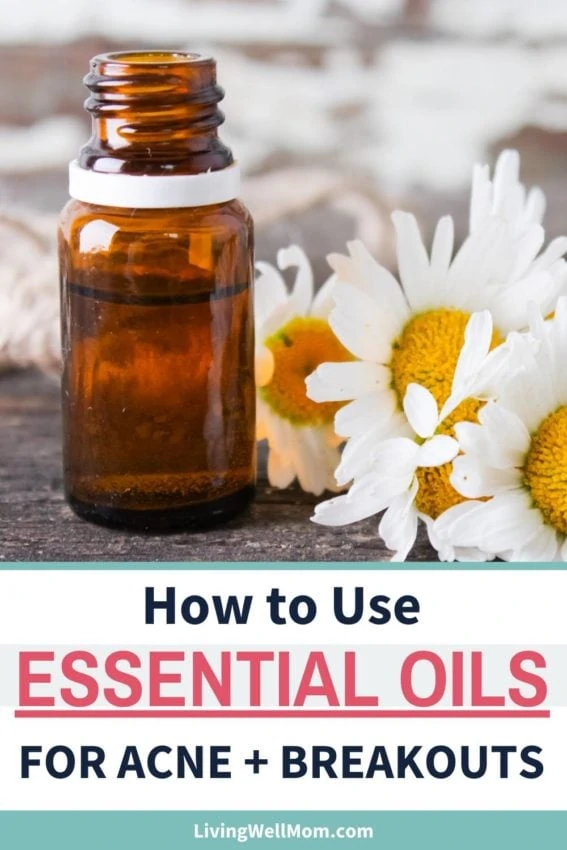
How to Use Essential Oils for Acne
If you asked me which essential oils are the best for acne-prone skin, I would have to say, in my opinion, I believe that tea tree oil, geranium, frankincense, juniper berry, and roman chamomile are the top due to their beneficial properties and safe use.
Here is the simplest, fastest way to use essential oils to help with acne:
- Wash your face gently.
- Choose 2-4 essential oils and add 1-2 drops each to the palm of your hand
- Add an estimated 1-2 teaspoons of argan oil or your favorite carrier oil.
- Rub your hands together to mix the oils.
- Gently rub onto your face or wherever you are dealing with breakouts.
Do this once a day for a couple of days, then wait and see how your skin responds. If your skin loves it, then you may want to use your essential oils twice a day.
You do not have to use all of the 18 best essential oils for acne mentioned in this post. Use the essential oils you already have and consider adding one or more oils that really stand out to you.
How do I use Essential Oils for Baby Acne?
You should always check with your healthcare provider before using essential oils on young infants. Usually, baby acne will go away on its own without any treatment and is rarely severe.
When one of my babies had some longer-lasting acne, I made a 10ml roller blend with 1 drop of lavender and 1 drop of roman chamomile essential oils to 2 tsp fractionated coconut oil. I swiped this very gentle highly diluted blend just once over the worst area and it calmed and disappeared within 2 days.
Acne Soothing Essential Oil Recipe
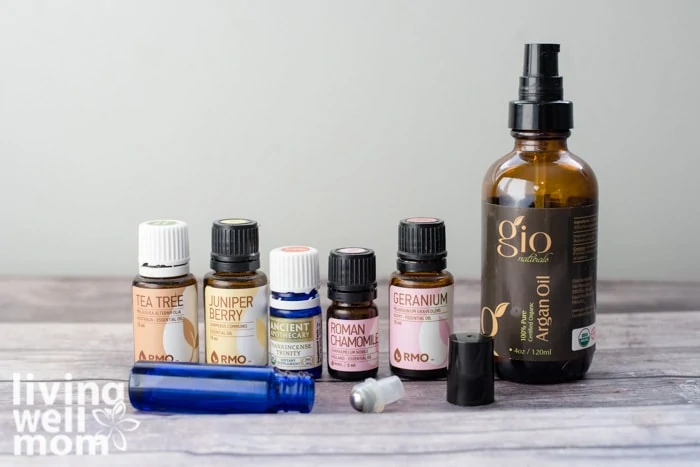
You will need:
- 10ml glass roller bottle
- carrier oil – I recommend argan oil for acne OR an alcohol-free witch hazel (which is an astringent)
- frankincense essential oil
- geranium essential oil
- juniper berry essential oil
- roman chamomile essential oil
- tea tree essential oil
If your skin is very sensitive, start with just 1 drop of each essential oil for a total of 5 drops. This is an approximately 1.8% dilution rate.
Otherwise, you can use 2 drops each: frankincense, geranium, roman chamomile, and tea tree and 1 drop juniper berry. This is a 3% dilution rate.
- Add the essential oils to your glass roller bottle.
- Fill the rest of the bottle with your carrier oil or witch hazel.
- Push the roller bottle onto the top.
- Shake or roll so the oils are mixed well.
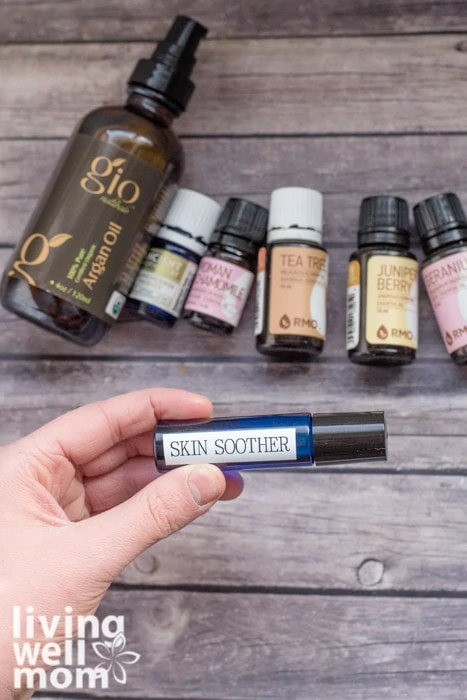
Video Tutorial for Acne Essential Oil Blend
How to Use this Essential Oil Roller for Acne:
After gently cleansing your face, roll this essential oil blend onto the blemishes. Allow it to absorb into your skin.
Use just once a day for a couple of days, then see how your skin reacts. If you are seeing good results, you may want to use it once a day.
I hope this post on using essential oils for pimples, breakouts, oily skin, and other issues has helped you.
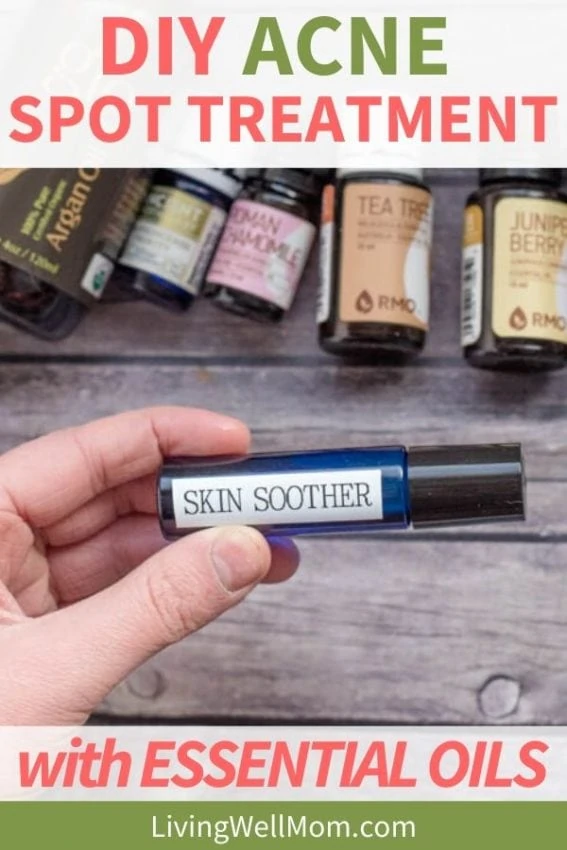
Here are more ideas/tips for using essential oils for skincare:
- 12 Best Essential Oils for Dry Skin
- Homemade Cuticle Oil with essential oils
- Softening DIY Cuticle Butter
- Homemade Cracked Heel Cream
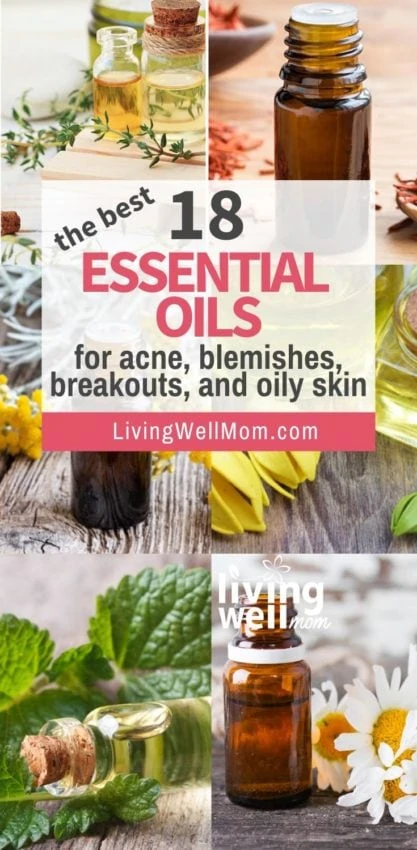
*Safety Notes are based on the recommendations of Robert Tisserand and Rodney Young from their book Essential Oil Safety book.
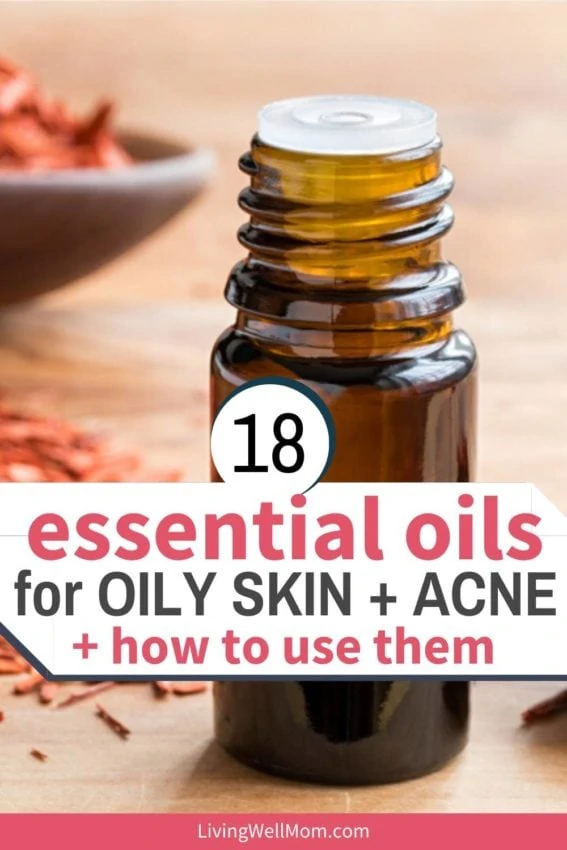
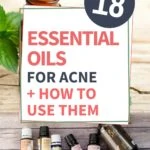
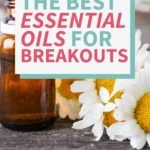
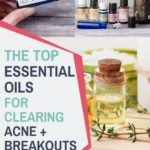
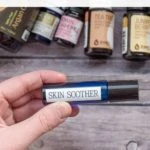
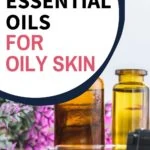
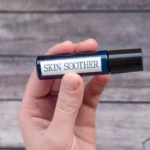
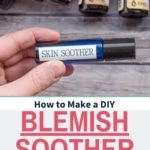
Aloysius says
Wow, this is very helpful – I didn’t know essential oils could be so helpful for breakouts.